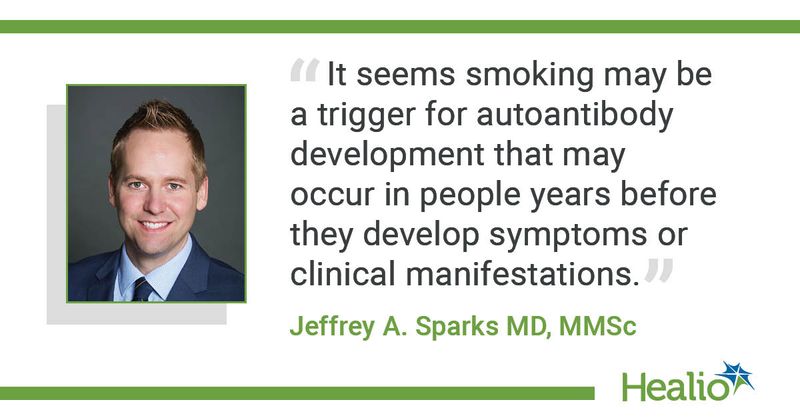Helping rheum patients quit smoking: ‘Even a small conversation can have a big impact’
Click Here to Manage Email Alerts
Although rates of smoking have steadily declined in recent decades, 34 million Americans still use cigarettes, according to the American Cancer Society, with many of those millions being patients with autoimmune and rheumatic diseases.
According to the CDC, more than 480,000 deaths can be attributed to smoking each year in the United States, making it the foremost source of preventable death and illness in the country.

Meanwhile, one does not have to dig too deeply into the PubMed archives to find data showing increased rates of smoking among patients with rheumatic diseases. Complications and comorbidities are prevalent, raising the urgency and necessity of quitting.
To discuss strategies for helping patients quit, the rise of vaping in older and younger patient populations, and ways organizations like the American College of Rheumatology can help, Healio sat down with Karen H. Costenbader, MD, MPH, director of the lupus program, and Jeffrey A. Sparks MD, MMSc, associate program director of rheumatology fellowship, director of immuno-oncology and autoimmunity, and director of the Joint Biology Consortium’s Human Biosamples Core, both at Brigham and Women’s Hospital.

Healio: Of course, smoking is bad for everyone. That said, what are the rheumatic and autoimmune conditions for which smoking is particularly risky or concerning?
Costenbader: Smoking is extremely dangerous for your health in multiple ways. According to the CDC, smoking is still the leading cause of preventable disease, disability and death in the United States. It is responsible for more than one in five deaths. It has been shown repeatedly that smoking also puts people without autoimmune rheumatic disease at higher risk of developing conditions like lupus and rheumatoid arthritis.
Meanwhile, those with rheumatic and autoimmune conditions have worse outcomes if they smoke, including lung disease, cancer, heart disease and increased disease activity, making it difficult to control inflammatory arthritis, for example. This is well proven in many past studies of people with RA, systemic and cutaneous lupus, scleroderma, myositis and even multiple sclerosis. People with all of these diseases have increased disease activity, more and worse complications, and have much worse outcomes, if they smoke.
Sparks: I would add that smoking is also of concern in ANCA-associated vasculitis. Thus, smoking likely contributes to the spectrum of systemic rheumatic diseases.
Healio: Beyond the obvious, what are the risks in those particular patients?
Sparks: It seems smoking may be a trigger for autoantibody development that may occur in people years before they develop symptoms or clinical manifestations. This also implicates other inhalants into systemic rheumatic disease pathogenesis. For people with systemic rheumatic diseases, it may contribute to flares, organ damage, and more severe disease manifestations.
Costenbader: Fortunately, smoking rates have declined over the decades, but people do continue to smoke. Smoking is much more common today in Europe and Asia than it is in the United States, but young people are picking it up again. More men still smoke and tend to be heavier smokers than women, but not by much. Around 13% of adult men and 10% of adult women in the United States still smoke.
Healio: How do you talk to your patients about quitting? What strategies do you use or recommend?
Sparks: Many patients do not know that there is any relationship between smoking and the presence and activity of their systemic rheumatic disease. This can sometimes motivate them beyond the other known health benefits of quitting smoking.
Costenbader: I talk frequently to my patients who smoke about quitting, and we have even had some success. Of course, I provide copious evidence that smoking is very bad for their health, as well as lots of encouragement and positive reinforcement. I talk about tapering off cigarettes in the same way that I talk about tapering off corticosteroids. Both are addictive and you have to go down slowly and move in the right direction. I suggest setting quit dates and giving yourself rewards for staying off.
There are smoking cessation clinics, smoking cessation medications and multiple strategies available online. Family and social support and support groups really help as well.
Healio: What thoughts or advice do you have for your rheumatology colleagues about talking to patients about quitting?
Sparks: Patients really value the advice from their rheumatology provider. Even a small conversation can have a big impact on patient behavior.
Healio: How serious is the issue of vaping? Is this a more serious concern in younger or adolescent patients, or are you seeing it in patients of all ages?
Costenbader: Vaping is on the rise, but luckily there is some new legislation making vapes less available for young people. These were really shamelessly marketed for younger adults, and even adolescents and kids.
Unfortunately, the serious health consequences of vaping have not even been thoroughly studied yet. However, vaping is associated with lung disease, and since many of the effects of cigarettes on autoimmune disease are through pulmonary inflammation, it is very likely that vaping poses serious health concerns for autoimmune rheumatic diseases in the same way.
Sparks: Vaping is certainly more prevalent in younger populations, but it seems uptake may increase even in older people. The impact of vaping on susceptibility and outcomes in systemic rheumatic disease patients needs to be studied.
Healio: What can organizations like the ACR do to help patients quit?
Sparks: Increasing education about the relationship of smoking with systemic rheumatic diseases is needed beyond its other known health risks. The ACR could provide resources to physicians and patients about methods to quit smoking.
Reference:
American Cancer Society Great American Smokeout site:
https://www.cancer.org/cancer/risk-prevention/tobacco/great-american-smokeout.html
